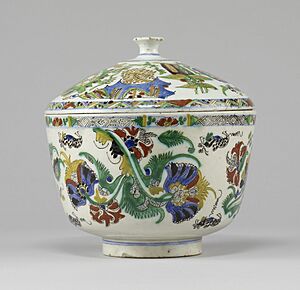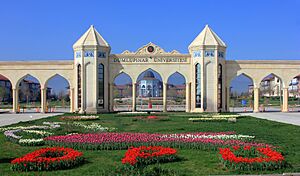Kütahya facts for kids
Quick facts for kids
Kütahya
|
||
|---|---|---|

Kütahya view
|
||
|
||
| Country | Turkey | |
| Province | Kütahya | |
| District | Kütahya | |
| Elevation | 970 m (3,180 ft) | |
| Population
(2022)
|
263,863 | |
| Time zone | TRT (UTC+3) | |
| Postal code |
43000
|
|
| Area code | 0274 | |
Kütahya is a city in western Turkey. It lies on the Porsuk River, about 969 meters (3,179 feet) above sea level. Kütahya is the main city of its province and district. In 2022, its population was 263,863 people. The area around Kütahya has gentle slopes for farming. It also has high mountain ridges to the north and west.
Contents
History of Kütahya
Ancient Times: Greece, Rome, and Byzantium
In ancient times, Kütahya was known as Cotyaeum. It became part of the Roman province of Phrygia Salutaris. Around 820 AD, it became the capital of a new province.
Church History
Cotyaeum was an important center for the early Christian church. Its main church leader, called a bishop, became a metropolitan. This meant they had authority over other bishops in the area. Many bishops from Cotyaeum attended important church meetings. Today, Cotyaeum is listed by the Catholic Church as a titular see. This means it's a former bishopric that no longer has a resident bishop.
Justinian's Fortifications
During the rule of the Byzantine Emperor Justinian I, the city was made stronger. It was protected by two lines of walls and a strong castle. These defenses helped keep the city safe.
Later Periods: Seljuk, Crusader, and Ottoman Rule
Political Changes (11th Century to 1867)
Around 1071, Cotyaeum briefly fell to the Seljuk Turks. The Byzantines later took it back. It changed hands several times, being captured by different groups. Finally, in 1428, it became part of the Ottoman Empire. For a long time, it was an important administrative center. In 1833, troops from Egypt briefly took control of the city.
Armenian Ceramics
During the Ottoman period, many Christian Armenians moved to Kütahya. They became very skilled in making tiles and ceramic pottery. Kütahya became famous for its beautiful ceramic art. These tiles and pottery were used in mosques, churches, and other important buildings across the Middle East.
A famous Armenian ceramic artist, David Ohannessian, worked in Kütahya. He later helped start the Armenian ceramics craft in Jerusalem. Today, two families from Kütahya continue this tradition in East Jerusalem. The Balian studio, known as Armenian Ceramics - Balian, is famous for its ceramic tile murals.
City Fortifications
The city and its surrounding areas had many fortifications. These were very important for safety and trade. They were built and rebuilt from ancient times through the Ottoman period.
Late 19th and Early 20th Century History
In the late 1800s, Kütahya had a mix of people. Most were Turks and other Muslims, but there were also Greeks, Armenians, and Catholics. During a difficult time in 1915, the Ottoman governor, Faruk Ali Bey, tried hard to protect the Armenian people in Kütahya. He prevented them from being forced to leave. However, he was removed from office in 1916. After that, the Armenian community in the city faced hardships.
Kütahya was occupied by the Greek Army in 1921 during the Turkish War of Independence. It was later recaptured by the Turkish Army in 1922.
Economy of Kütahya

Kütahya has a long history of different industries. It is especially known for its kiln products. These include colorful, glazed tiles and pottery.
Modern industries in Kütahya include sugar refining and tanning. They also process nitrate and make products from meerschaum. Meerschaum is a soft white mineral found nearby.
In the past, Kütahya was a big center for cotton production. Today, local farms grow cereals, fruits, and sugar beet. Raising livestock (farm animals) is also very important. There are also important mines near Kütahya that dig up lignite, a type of coal.
Kütahya is connected to other major cities by rail and road. These include İstanbul, Ankara, and Eskişehir.
Traditional Ceramics
Kütahya has a rich history of making beautiful ceramics. An old small ewer (a type of pitcher) in the British Museum is famous. It has an Armenian inscription that says it was made for Abraham of Kütahya in 1510. This piece helped experts understand the history of pottery in the region.
Experts believe that 'Abraham of Kütahya' pottery was made from 1490 to about 1525. Other styles, like 'Damascus' and 'Golden Horn' ware, followed. 'Rhodian' ware was made later. This shows how important Kütahya was in the history of ceramic art.
Climate of Kütahya
Kütahya has a climate with warm, dry summers and chilly, wet, often snowy winters. This is called a warm-summer Mediterranean climate. Rain and snow mostly happen in winter and spring, but can occur throughout the year.
The highest temperature ever recorded was 41.4°C (106.5°F) on August 15, 2023. The lowest temperature ever recorded was -28.1°C (-18.6°F) on December 29, 1948.
| Climate data for Kütahya (1991–2020, extremes 1929–2023) | |||||||||||||
|---|---|---|---|---|---|---|---|---|---|---|---|---|---|
| Month | Jan | Feb | Mar | Apr | May | Jun | Jul | Aug | Sep | Oct | Nov | Dec | Year |
| Record high °C (°F) | 19.1 (66.4) |
24.2 (75.6) |
27.0 (80.6) |
30.2 (86.4) |
34.3 (93.7) |
36.2 (97.2) |
39.5 (103.1) |
41.4 (106.5) |
38.4 (101.1) |
31.9 (89.4) |
26.0 (78.8) |
21.7 (71.1) |
39.5 (103.1) |
| Mean daily maximum °C (°F) | 5.1 (41.2) |
7.7 (45.9) |
11.8 (53.2) |
16.8 (62.2) |
21.9 (71.4) |
25.9 (78.6) |
29.2 (84.6) |
29.4 (84.9) |
25.4 (77.7) |
19.7 (67.5) |
13.2 (55.8) |
6.8 (44.2) |
17.7 (63.9) |
| Daily mean °C (°F) | 0.6 (33.1) |
2.3 (36.1) |
5.8 (42.4) |
10.2 (50.4) |
15.0 (59.0) |
18.8 (65.8) |
21.6 (70.9) |
21.6 (70.9) |
17.4 (63.3) |
12.4 (54.3) |
6.6 (43.9) |
2.4 (36.3) |
11.2 (52.2) |
| Mean daily minimum °C (°F) | −2.7 (27.1) |
−1.8 (28.8) |
0.8 (33.4) |
4.4 (39.9) |
8.6 (47.5) |
12.0 (53.6) |
14.5 (58.1) |
14.7 (58.5) |
10.4 (50.7) |
6.7 (44.1) |
2.0 (35.6) |
−0.7 (30.7) |
5.7 (42.3) |
| Record low °C (°F) | −26.3 (−15.3) |
−27.4 (−17.3) |
−16.6 (2.1) |
−7.8 (18.0) |
−2.8 (27.0) |
0.5 (32.9) |
2.6 (36.7) |
−0.2 (31.6) |
−3.9 (25.0) |
−6.9 (19.6) |
−11.0 (12.2) |
−28.1 (−18.6) |
−28.1 (−18.6) |
| Average precipitation mm (inches) | 64.2 (2.53) |
53.3 (2.10) |
53.0 (2.09) |
52.8 (2.08) |
57.5 (2.26) |
43.6 (1.72) |
19.2 (0.76) |
24.6 (0.97) |
26.7 (1.05) |
43.2 (1.70) |
45.3 (1.78) |
67.2 (2.65) |
550.6 (21.68) |
| Average precipitation days | 13.3 | 12.23 | 12.83 | 11.87 | 12.03 | 8.53 | 3.6 | 4.47 | 5.37 | 8.9 | 8.83 | 13.6 | 115.6 |
| Average snowy days | 8.2 | 5.6 | 4.1 | 0.9 | 0 | 0 | 0 | 0 | 0 | 0.1 | 1.3 | 4.2 | 24.4 |
| Average relative humidity (%) | 77.7 | 71.9 | 65.7 | 62.8 | 62.4 | 61.2 | 57.3 | 58.7 | 61.6 | 68.2 | 71.9 | 78.1 | 66.5 |
| Mean monthly sunshine hours | 68.2 | 98.9 | 145.7 | 189.0 | 229.4 | 273.0 | 319.3 | 297.6 | 225.0 | 161.2 | 114.0 | 65.1 | 2,186.4 |
| Mean daily sunshine hours | 2.2 | 3.5 | 4.7 | 6.3 | 7.4 | 9.1 | 10.3 | 9.6 | 7.5 | 5.2 | 3.8 | 2.1 | 6.0 |
| Source 1: Turkish State Meteorological Service | |||||||||||||
| Source 2: NOAA(humidity) Meteomanz(snow days 2003-2023) | |||||||||||||
Culture in Kütahya
Kütahya's older neighborhoods have many traditional Ottoman houses. These homes are made of wood and stucco. You can see some of the best examples along Germiyan Caddesi. The city also has many historic mosques, like Ulu Camii and Cinili Camii. The Şengül Hamamı is a famous Turkish bath.
The town has some ancient ruins, including a Byzantine castle and an old church. For centuries, Kütahya has been known for its Turkish earthenware. You can see beautiful examples of this pottery in museums. The Kütahya Museum has a great collection of local art and cultural items. The house where Hungarian statesman Lajos Kossuth lived in exile is now a museum.
Education in Kütahya
The main campus and the Germiyan Campus of the Kütahya Dumlupınar University are located in the city. This university offers many different study programs.
Transportation in Kütahya
Kütahya has a main bus station with connections to most major Turkish cities. Zafer Airport is also active, making travel easier. Kütahya is an important railroad hub for the Aegean region of Turkey.
International Connections
Kütahya has "twin city" relationships with several cities around the world. These connections help promote cultural exchange and friendship.
Notable People from Kütahya
Many interesting people have come from Kütahya:
- Alexander of Cotiaeum (c.70-80CE – c.150CE), a Greek grammarian (someone who studies language rules).
- Evliya Çelebi (1611–1682), a famous traveler and writer.
- Komitas (1869–1935), an Armenian composer and musicologist (someone who studies music).
- Âsım Gündüz (1889–1970), a military officer.
- Hisarlı Ahmet (1908–1984), an ashik (a traditional folk poet-singer).
- Mustafa Kalemli (born 1943), a politician.
- Ayla Dikmen (1944–1970), a singer.
- Abdullah Aymaz (born 1949), a writer and journalist.
- Aydilge Sarp (born 1979), a singer.
- Halil Akkaş (born 1983), a middle-distance runner.
- Özge Kırdar (born 1985), a volleyball player.
- Veli Kızılkaya (born 1985), a football player.
- Danla Bilic (born 1994), an internet personality.
- Hande Baladın (born 1997), a volleyball player.
See also
- Aizanoi, a nearby ancient city
- Anatolian Tigers
- Evliya Çelebi Way
- Iznik pottery, a style of ceramics known from Iznik and Kütahya
- Kumari (Kutahya)
Images for kids
































